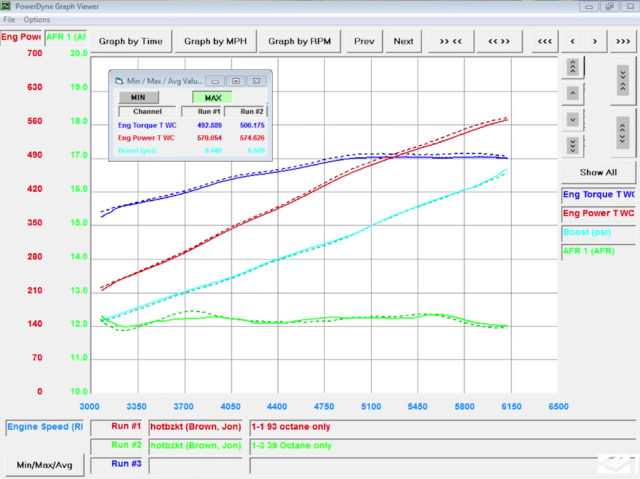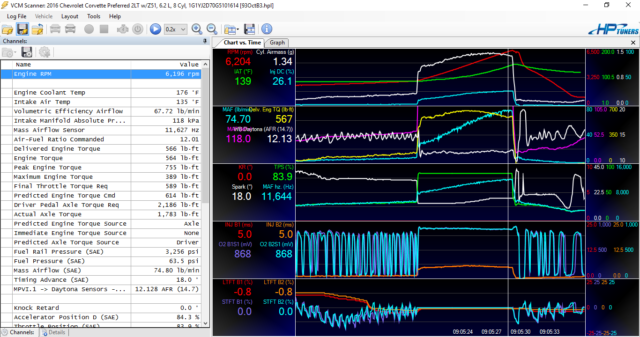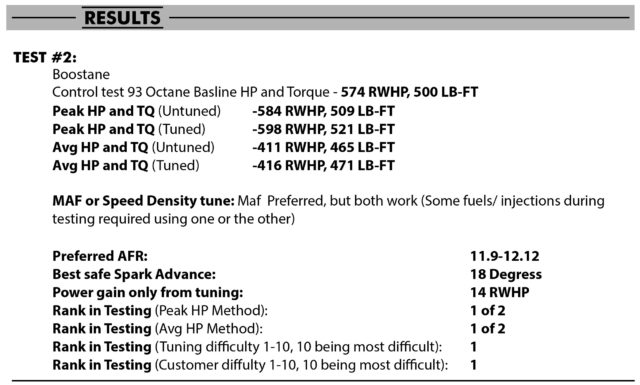This article is the second of our “Big Fuel Test” series that spans 13 different test fuels, octane additives and injections. During this article, we will be discussing how the octane additive “BOOSTane Professional” performed, what upsides and downsides may potentially be. Do yourself a favor, and read this one. It surprised us, and I think it will surprise you, too
Our test car makes about 400-rwhp naturally aspirated, and 574-rwhp on 8 psi of boost peaking at 6,200 rpm on The Tuning School’s Mustang Chassis Dynamometer (Model MD-1750) on pump gas, 93 octane.
Each test performed was done with the same 4th gear pull, the same test range of 3,000-6,200 rpm. For all tests we held the boost the same, but used spark advance, as well as adjusted the air/fuel ratio to find the best safe power each fuel would make. We used HP Tuners for the tuning. Below is our baseline dyno chart on pump gas, 93 octane with 2 pulls charted.
Performance Numbers:
This is where the surprises of this test series really begin. Most people we talked to didn’t bet on this one being a winner. The reality was that we noticed improvements in power and spark tolerance right off the bat. With no changes to the tune, only adding BOOSTane, we gained 10 rwhp. With a safe 18 degrees of spark advance from a little tuning, only 3 degrees more than our base pump gas test, we were now making even better power, up from 574-rwhp to 598-rwhp, a gain of 24 horsepower. Also, we found increases in torque – from an even 500 lb-ft at the wheels on pump gas to 521 lb-ft. With no knock, and excellent power gains, we were really impressed with BOOSTane.
As you can see from the dyno chart above, the gains were not just peak, but really picked up from 4,000 rpm and above. With more time spent tuning the 3,000-5,000 rpm range, we suspect we could have found another 10 rwhp with refining the spark for more gains in that range as the BOOSTane helped with spark tolerance greatly.
In this scan, we can see the engine is making maximum power and torque safely, with 18 degrees of spark advance, no knock and an air/fuel ratio of about 12.13:1. The engine was consuming about 74 lb/min of air, up from about 71 lb/min of airflow on the 93 octane only.
The air/fuel ratio leaned out about half a point after pouring in the BOOSTane, and with no changes we noted a 10 rwhp gain, indicating the presence of some power improving compounds.
A general rule of thumb we teach is that a forced induction engine will typically generate 9.5-10.5 hp for every lb/min of airflow. This means you can estimate power from the airflow reported. Keep in mind this is engine horsepower, and must be reduced by 15-25% to account for drivetrain losses to convert to Rear Wheel Horsepower (RWHP) to get close to what your dynamometer reports. However, we prefer to use it as a measurement of improvement (before/after a tune upload) to see that power increases, and thus it will confirm when our dynamometer shows increases in power.
So, here’s the details of the BOOSTane results:
As we continued our testing, we added another 2 degrees and found power gains that were even better – making the race fuels we would test jealous. Now making 613 rwhp and 534 lb-ft of torque (improvements of 39 rwhp and 34 lb-ft over 93 octane pump gas only), it would set record numbers that would take the heaviest hitters of our test to later dethrone.
However, given our test’s rules, sadly we had to disqualify these results as we began to encounter light knock as indicated with our Plex Knock monitor. We could audibly hear it through the Plex earphones and observe a few knock counts on the monitor. To be honest, we debated this test and the morals of disqualifying it because of the knock during the run, as it was so mild.
In the end, we came to the conclusion that if we were at the drag strip and wanted a race only tune that was the hottest we could get for one pass, we all agreed, we would run it. But would we run it daily? No, and we all agreed on that difference being important – and thus we disqualified the results of the 20 degree advance test – in order to keep our results fair and consistent with the rules with all the other fuels. We held all the other fuels to the same standard – when knock began, we stopped and didn’t count that pull towards final results for this test series.
Below, the gains of the 20 degree spark advance test of BOOSTane over pump gas are dramatic.
Results Summary:
This was our second test of the shootout, and the only additive that was entered into our showdown. BOOSTane is a race fuel concentrate, and claims to be a cost effective alternative to achieving up to about 110 octane. Judging by our test results, we would agree.
Over 110 octane concentration, as you get closer to 116, it becomes closer to race fuel costs, thus negating some of the value it provides.
After testing the product, here’s what we think:
Pros:
- Product works very well (many products in this segment typically do not).
- Product has much lower cost to improve power to race gas octane levels than race gas does. For example, 1 bottle (quart) treating 17.5 gallons of 93 octane, makes it into 101 octane. When you consider the cost of the base 93 octane fuel and the BOOSTane additive, the cost per gallon at this ratio is about $5/gallon, which is much cheaper than a typical race fuel of 101 octane.
- Product easily mixes. When tested on the street, it mixed within an eighth mile of pouring it in the tank, showing improvements immediately. When on the dyno, we observed slower mixing times (30-45 mins) due to lack of fuel sloshing around. This made the product dependent on a fuel return mixing back into the tank, or simply time mixing and propagating with the original fuel in the tank.
- BOOSTane produces race fuel level results or better (see upcoming tests).
- Easy transportation to and from race venues. 1 bottle (quart) goes with 1 tank of fuel.
Cons:
- When tuned for BOOSTane, the car will need a steady diet of the product with each fill-up of the tank. In this way, it isn’t really different than making a race fuel tune for the car, as it would require a separate tune from pump gas too. The upside here is the costs to run BOOSTane long term are much cheaper than race fuels, but you get race fuel level power.
- Mixing on the dyno was a bit slow because we didn’t slosh the fuel like what normally happens when driving.
- Performance is dependent on base fuel quality (pump gas). For example, if you are working with a lower performing base fuel than we did, such as a 91 octane fuel, you are working with a 2-octane point disadvantage compared to our tests. This means there will be a larger difference in power and spark tolerance when compared to race fuel than what we observed, as we began with 93 octane as our base fuel.
We rank the tuning difficulty for BOOSTane as 1, or “easy” and customer difficulty of use as 1, also “easy.” We ranked them both easy because dialing in the tune calibration was simple, as no tricky fuels were in play, and the customer can obviously find pump gas everywhere and pour in some boostane from the bottle. The only tune revisions required were more airflow and thus more fuel, and increasing spark; all normal tuning changes any competent tuner can complete.
Driveability is also good (no cold start issues, like you see when running ethanol based fuels, for example).
Tuning Notes:
Tuning on BOOSTane resulted in a maximum safe spark advance of 18 degrees. We measured this with our Plex Knock Monitor as a known method to prove when we encountered real knock. We added spark advance 2 degrees at a time until stopping at 18, because knock occurred at 20 degrees, although considerably more power could have been made (see above charts) if we could risked keeping the extra spark advance. We would actually do this for a drag race only tune, as the knock presented was quite mild and only occasional.
The air/fuel ratio leaned out about half a point after pouring in the BOOSTane, and with no changes we noted a 10 rwhp gain, indicating the presence of some power improving compounds. Whether this was a result of a chemical change to the fuel, or an increase in the energy / oxygen in the fuel from BOOSTane, there was a definitive change as noted by our dual widebands and the required tune changes, and the extra 10 rwhp with no tune changes.
Power was safe at a reasonable 11.8 -12.2:1, keeping in mind that direct injection cars tend to prefer .5 AFR leaner than port fuel injection cars.
Conclusion:
So – we can conclude that if you are in the market for a very respectable increase in power with little investment, BOOSTane could be great for you. You can buy it easily, have it shipped to your door, make a few small changes to the tune on the dyno and have large, consistent gains with race gas levels of power and easy portability of the product versus heavy race fuel jugs. For now, it sits as the highest ranking power yet, but we have many more tests to come.
So, what’s next? Our next test changes it up as we reveal the results of the injections – and show you the gains made with the Snow Performance Water-Meth Injection system and how it compares to BOOSTane and 93 octane pump gas only. Furthermore – how will water injection do against methanol or Boost Juice? The age old argument of what to inject will be answered. This and many more test results are ready; coming up next!



























